 The "recount" is not going well so far for Virginia state Senator Mark Obenshain (R). What had been the closest statewide race in history, while still close, is beginning to open up for state Senator Mark Herring (D), who had been previously certified by the State Board of Elections as the "winner" of the November 5th state Attorney General's race.
The "recount" is not going well so far for Virginia state Senator Mark Obenshain (R). What had been the closest statewide race in history, while still close, is beginning to open up for state Senator Mark Herring (D), who had been previously certified by the State Board of Elections as the "winner" of the November 5th state Attorney General's race.
After two days of what suffices for a "recount" in the Old Dominion's election to replace outgoing Republican AG Ken Cuccinelli, Herring's state-certified 165 vote lead prior to the "recount" expanded to more than 800 votes on Tuesday, out of more than 2.2 million cast. According to the Democrat's campaign, more than 70% of the votes have now been re-tallied across the commonwealth as of Tuesday night. The three-days of re-tallying will end Wednesday, with a three-judge panel in Richmond making the final determinations on any challenged ballots by Friday.
Herring may have hired MN Sen. Al Franken's election recount attorney to represent him in VA, but the three-day affair there, so far, is nothing like the epic six-month-plus post-election hand-count in the 2008 U.S. Senate race between Franken and his Republican opponent Sen. Norm Coleman.
There, every single paper ballot was examined publicly, by hand. The time it took was, in no small part, due to the transparent thoroughness of the counting, but perhaps much more to Coleman's attempts to challenge everything he possibly could, arguably as a way to forestall what would become a very short-lived filibuster-proof Democratic super-majority in the U.S. Senate once Franken was finally seated in July of 2009.
In Virginia, as we've described several times in detail, the "recount" process is barely a count at all, given that most votes in the state are still cast on 100% unverifiable (and unrecountable) Direct Recording Electronic (DRE, usually touch-screen) voting systems. The rest of the votes are cast on paper ballots, but those are tallied by often-inaccurate, easily-gamed optical-scan computer tabulators, either correctly or incorrectly --- without a hand-count, there's no way to know. By Virginia's "recount" statute, almost all of those paper ballots are simply being run through the same optical-scanners again, rather than examined by human beings. The exception is ballots that register no vote for either candidate during the re-scanning. Those are then set aside and examined by hand during the "recount".
But, in a race as close as this one, there are more than enough paper ballots to flip the results from one candidate to the other during such a post-election tally.
In this case, however --- at least as of Tuesday night --- it's not looking good for Obenshain, as Herring is racking up more newly tallied votes than the Republican in almost every locality where there have been any changes to the totals at all...
With 73% of the votes re-tallied as of 6:30pm Tuesday, according to Marc Elias, formerly Franken's now Herring's attorney, the Democratic candidate's lead over Obenshain grew to 866 votes, presuming all of Republican's challenged ballots remain in the D column. If all of those challenges were to succeed, Herring would still have an 811 vote lead over Obenshain as of the completion of two of the three scheduled days of tallying.
Elias went on to add that, overall, Herring has picked up 1133 votes during the "recount" to date, while Obenshain has picked up just 432.
Herring's largest gains came from Fairfax County, which is the single largest voting jurisdiction in the state, with some 306,000 voters having cast ballots during the November 5th election. The county is heavily Democratic-leaning and voters there use hand-marked, computer-tallied paper ballots.
Due to its size, the county was allowed to begin their "recount" on Monday, before most of the other localities began on Tuesday. They completed all but their final audit by Tuesday night, according to Brian Schoeneman, one of two Republicans on Fairfax County's Electoral Board. (All localities in VA have Electoral Boards comprised of two Republicans and one Democrat, at least until the Governorship changes hands in January to Democrat Terry McAuliffe who defeated Cuccinelli in his run for Governor. Then, boards will be made up of two Democrats and one Republican.)
"Final unofficial numbers until we finish double check: Obenshain +206, Herring +572. Net Herring +366. 13 challenged ballots," Schoeneman tweeted last night after the final re-tallies wrapped up in Fairfax.
If Wednesday continues apace, Herring's "recount" victory should be concluded by Friday, when the three-judge special recount panel at the Richmond Courthouse will complete their review of challenged ballots.
After that, Obenshain will have until Monday to decide whether he wishes to exercise what some are calling the "nuclear option". Virginia election code allows the loser of the "recount" to file a contest. That contest is decided not by a court of law, but by a vote of a joint session of the VA state legislature, which is dominated by Republicans who are not very happy right now about the prospect of all three statewide offices --- Governor, Lt. Governor and Attorney General --- being controlled by Democrats for the first time since 1969.
A few observations, for now, based on the coverage coming out of Virginia:
• Miscounts everywhere. - As is often the case in post-election counts, the number of incorrect original tallies is somewhat marginalized by election officials and media alike. For example, when Candidate A gains 5 votes in one precinct during the "recount", but loses 5 in another precinct, election officials and media end up describing that county as having "no change" or as having been "perfectly counted" on Election Night. In fact, such a scenario represents at least 10 miscounted votes and, depending on how you look at it, a potential 20 vote difference as mistallied by the optical-scan system. In the scenario above, the 5 new votes counted for Candidate A may have initially been counted for Candidate B. That's a 10 vote swing (Candidate B would lose 5 votes at that precinct and Candidate A would gain 5 votes there.) In the precinct where Candidate A lost 5 votes in the recount, those votes might go to Candidate B instead, so there could be a 20 vote difference in that "perfect count" scenario.
Unless votes are examined by human beings, there is no way to know how votes were actually cast, when relying on computer optical-scan systems.
In Virginia, only paper ballot under-votes or over-votes are examined by hand during a "recount". So most of the vote pickups by both candidates, and there have been a lot of them, more than 1,500 so far, were likely votes that wouldn't have been tallied at all, but for the fact that the recount statute requires that ballots seen by the op-scanners as undervotes (having no vote for either candidate) be set aside by the computer and then examined by hand.
Again, if not for the very small percentage of hand-counts allowed in a Virginia "recount", those voters would have likely lost their votes entirely. As to the number of votes cast for one candidate, but recorded for the other by the optical-scanner, there is no way to know how many of those votes actually exist.
We've long-described op-scan systems as "often-inaccurate". Max Smith, a WTOP reporter observing the tallies in Fairfax on Monday, underscored that point near the end of that day's counting when he noted on Twitter: "As of 5pm...Only 6 of 67 precincts had no change." And that was after counting only ballots rejected by the optical-scanners, for some reason, during the "recount".
• Herring is gaining votes just about everywhere. - Most of the changes are happening, obviously, in paper ballot localities. In DRE localities, the "recount" statute specifies that "the recount officials shall open the envelopes with the printouts and read the results from the printouts." That's just about all there is to it when "recounting" the touch-screen systems. It's impossible to know if any vote cast on any of those computers was actually recorded accurately, as per any voter's intent.
So where there have been pickups, it has largely been in paper ballot localities. Why has the Democrat Herring been picking up more than the Republican Obenshain almost everywhere? Time will be needed to study this. Many of the localities where Herring has picked up votes over Obenshain were places that the Democrat reportedly won fairly handily. So, if op-scan errors were equally distributed, it makes sense that Herring would pick up more votes than Obenshain. But, according to this spreadsheet, maintained by Daniel Nichanian, formerly of Campaign Diaries, tracking the "recount" tallies, there are number of counties where Herring otherwise lost, but is still outpacing Obenshain on votes picked up during the "recount".
According to the spreadsheet, there are no counties or cities, so far, where the opposite is true, where Herring otherwise won, but where Obenshain has gained more pickups than Herring. That merits further examination.
• Very few challenged ballots - As in the 2008 Franken/Coleman challenge, this "recount" once again seems to put the lie to the argument put forward by proponents of electronic voting that computers are needed to take the human guesswork out of counting votes.
By the bitter end of Minnesota's U.S. Senate race challenge, out of nearly 3 million ballots cast and counted by hand during the post-election challenge, the state canvassing board there was only undecided on about a dozen ballots. The voter intent was clear enough for both parties to ultimately agree on just about every one of those 3 million votes. Hand-counting is not the chaotic, indiscernible process that proponents of electronic voting and tallying enjoy making it out to be. Voter intent is almost always discernible.
In Virginia, we are finding a similar pattern. Out of all the votes examined to date, there have so far been fewer than 120 challenged by partisan observers. Those will be adjudicated by the three-judge panel in Richmond by Friday. It is likely they will be able to agree, one way or another, on most of them. Even if they don't, 120 disputed ballots out of hundreds of thousands of paper ballots cast does not present a particularly persuasive argument against hand-marked or hand-counted paper ballots...at least not on the basis that humans are just too sloppy, stupid or incapable when voting, for other humans to agree upon their intent.
UPDATE 12:05pm PT: OBENSHAIN CONCEDES, DEMS SWEEP ALL STATEWIDE OFFICES. Details now here...
Previously related #VAAG coverage at The BRAD BLOG...
• E-Voting Trouble Reported During Today's Elections in Virginia, New York, and Elsewhere [11/5/2013]
• 'Recount' in Virginia AG Race? Good Luck With That. (But, Perhaps You Can Help) [11/6/2013]
• BREAKING: Thousands of Votes Discovered 'Unaccounted For' in Virginia AG Race [11/7/2013]
• Tallying VA's 'Missing' Op-Scan Votes; And Other Surprises in the Incredibly Close VA AG Election [11/8/2013]
• Down to the Provisionals: 55 Vote Margin (or less) Out of 2.2 Million Cast in Virginia AG Race [11/9/2013]
• BREAKING: Democratic Candidate Takes Lead in Razor-Thin VA Attorney General Tally [11/11/2013]
• Provisional Votes Tallied in Fairfax County, VA - Last Ballots Before Certification of the Razor-Thin VA AG Race [11/12/2013]
• BREAKING: Democrat Mark Herring 'Wins' VA Attorney General Race by 164 Votes Before Final State Certification, Almost Certain 'Recount' [11/12/2013]
• VA AG Race: About That 500+ Vote Republican Pickup in Bedford County [11/20/2013]
• Yes, Santa Claus, There is a Virginia: 'Recount' and Potential 'Contest' Still Ahead in VA AG Race [12/3/2013]


 Sunday 'TACO Trump on Every Corner' Toons
Sunday 'TACO Trump on Every Corner' Toons Sunday 'Cutting Corners' Toons
Sunday 'Cutting Corners' Toons 'A World of Tyrants,
'A World of Tyrants, 'Green News Report' 5/22/25
'Green News Report' 5/22/25
 Climate Scientist Warns Trump 'Censorship' Endangering NatSec: 'BradCast' 5/21/25
Climate Scientist Warns Trump 'Censorship' Endangering NatSec: 'BradCast' 5/21/25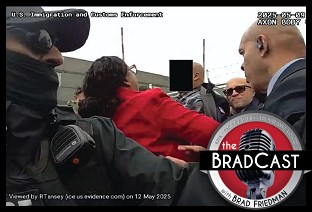 And Then They Came for Members of Congress...: 'BradCast' 5/20/25
And Then They Came for Members of Congress...: 'BradCast' 5/20/25 'Green News Report' 5/20/25
'Green News Report' 5/20/25 Court Blocks Last Route for Voter Challenges Under VRA: 'BradCast' 5/19/25
Court Blocks Last Route for Voter Challenges Under VRA: 'BradCast' 5/19/25 Sunday 'Now Hoarding' Toons
Sunday 'Now Hoarding' Toons Mad World: 'BradCast' 5/15/2025
Mad World: 'BradCast' 5/15/2025 'Green News Report' 5/15/25
'Green News Report' 5/15/25 Plane Corruption and the Future of the DOJ: 'BradCast' 5/14/25
Plane Corruption and the Future of the DOJ: 'BradCast' 5/14/25 GOP Proposes 'Deeply Evil' Cuts to Medicaid: 'BradCast' 5/13/25
GOP Proposes 'Deeply Evil' Cuts to Medicaid: 'BradCast' 5/13/25 And Then They Came for the Mayors...: 'BradCast' 5/12/25
And Then They Came for the Mayors...: 'BradCast' 5/12/25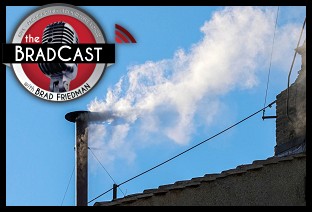 Blowing Smoke. At the Vatican and White House: 'BradCast' 5/8/25
Blowing Smoke. At the Vatican and White House: 'BradCast' 5/8/25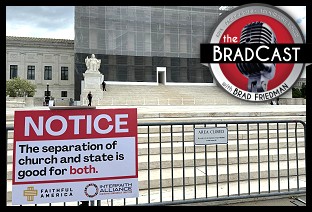 SCOTUS Weighs Public Funding of Religious Schools: 'BradCast' 5/7/25
SCOTUS Weighs Public Funding of Religious Schools: 'BradCast' 5/7/25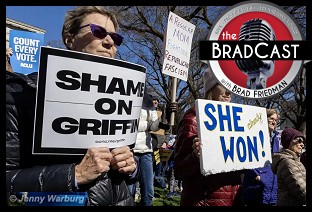 Trump Judge Blocks NC GOP Theft of 2024 Supreme Court Seat: 'BradCast' 5/6/25
Trump Judge Blocks NC GOP Theft of 2024 Supreme Court Seat: 'BradCast' 5/6/25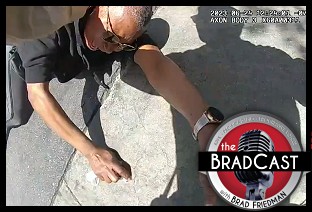 Prosecutors Quit After U.S Attny Strikes Deal With Felon Cop: 'BradCast' 5/5/25
Prosecutors Quit After U.S Attny Strikes Deal With Felon Cop: 'BradCast' 5/5/25 Trump Losing Streak Continues into SECOND Hundred Days: 'BradCast' 5/1/25
Trump Losing Streak Continues into SECOND Hundred Days: 'BradCast' 5/1/25
 VA GOP VOTER REG FRAUDSTER OFF HOOK
VA GOP VOTER REG FRAUDSTER OFF HOOK Criminal GOP Voter Registration Fraud Probe Expanding in VA
Criminal GOP Voter Registration Fraud Probe Expanding in VA DOJ PROBE SOUGHT AFTER VA ARREST
DOJ PROBE SOUGHT AFTER VA ARREST Arrest in VA: GOP Voter Reg Scandal Widens
Arrest in VA: GOP Voter Reg Scandal Widens ALL TOGETHER: ROVE, SPROUL, KOCHS, RNC
ALL TOGETHER: ROVE, SPROUL, KOCHS, RNC LATimes: RNC's 'Fired' Sproul Working for Repubs in 'as Many as 30 States'
LATimes: RNC's 'Fired' Sproul Working for Repubs in 'as Many as 30 States' 'Fired' Sproul Group 'Cloned', Still Working for Republicans in At Least 10 States
'Fired' Sproul Group 'Cloned', Still Working for Republicans in At Least 10 States FINALLY: FOX ON GOP REG FRAUD SCANDAL
FINALLY: FOX ON GOP REG FRAUD SCANDAL COLORADO FOLLOWS FLORIDA WITH GOP CRIMINAL INVESTIGATION
COLORADO FOLLOWS FLORIDA WITH GOP CRIMINAL INVESTIGATION CRIMINAL PROBE LAUNCHED INTO GOP VOTER REGISTRATION FRAUD SCANDAL IN FL
CRIMINAL PROBE LAUNCHED INTO GOP VOTER REGISTRATION FRAUD SCANDAL IN FL Brad Breaks PA Photo ID & GOP Registration Fraud Scandal News on Hartmann TV
Brad Breaks PA Photo ID & GOP Registration Fraud Scandal News on Hartmann TV  CAUGHT ON TAPE: COORDINATED NATIONWIDE GOP VOTER REG SCAM
CAUGHT ON TAPE: COORDINATED NATIONWIDE GOP VOTER REG SCAM CRIMINAL ELECTION FRAUD COMPLAINT FILED AGAINST GOP 'FRAUD' FIRM
CRIMINAL ELECTION FRAUD COMPLAINT FILED AGAINST GOP 'FRAUD' FIRM RICK SCOTT GETS ROLLED IN GOP REGISTRATION FRAUD SCANDAL
RICK SCOTT GETS ROLLED IN GOP REGISTRATION FRAUD SCANDAL VIDEO: Brad Breaks GOP Reg Fraud Scandal on Hartmann TV
VIDEO: Brad Breaks GOP Reg Fraud Scandal on Hartmann TV RNC FIRES NATIONAL VOTER REGISTRATION FIRM FOR FRAUD
RNC FIRES NATIONAL VOTER REGISTRATION FIRM FOR FRAUD EXCLUSIVE: Intvw w/ FL Official Who First Discovered GOP Reg Fraud
EXCLUSIVE: Intvw w/ FL Official Who First Discovered GOP Reg Fraud GOP REGISTRATION FRAUD FOUND IN FL
GOP REGISTRATION FRAUD FOUND IN FL

































